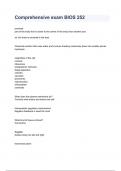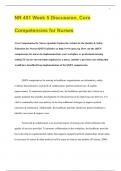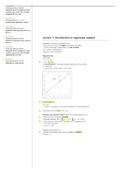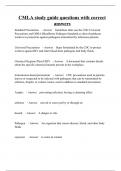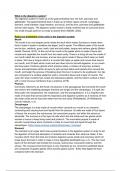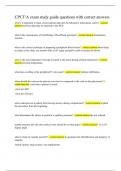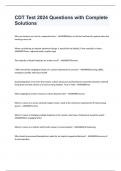Lecture 15 Evolution of the body plans: general
principles
A single cell (zygote) contains all information on the adult body plan. Body plans enroll step by step:
Signaling gradients, axis formation
Cell differentiation & fate determination
Proliferation, apoptosis, cell migration
Modularity, segmentation
Organogenesis
Maturation, timing (heterochrony), neoteny
In the phylotypic stage (mid-embryogenesis), the embryo’s of different look mostly alike. Adaptive
diversity is seen in later stages and reproductive diversity is seen in the early stages. The genetic toolbox
for development is evolutionary extremely conserved.
, The development of the embryo starts with tissue patterning and body axes. There are two types of
body axes: anterior & posterior (front & rear) and dorsal and ventral (back & belly). This direction is
essential to coordinate organs and tissues. The Drosophila is a very important model for axis formation.
Many basal embryonic features of the Drosophila predate the split between protostomes and
deuterostomes. Their developmental molecular toolbox also predates this split. There are a lot of
homologous genes between the Drosophila and mammals. The developing eggs of the Drosophila are
provisioned with maternal mRNA during oogenesis. However, zygotes typically do not commence
transcription until after 2-3 divisions. Drosophila eggs
already have a dorsal-ventral axis induced by its mother.
Bicoid (Bcd protein) is essential for the formation of the
anterior-posterior axis. Bicoid is the morphogen for the
head and thorax development. A morphogen is a
compound with a non-uniform distribution establishing
positions of specialized cell types and tissues.
Transplantation of Bicoid-containing cells induces
ectopic (away from normal position) anterior identity.
Bicoid suppresses caudal in the anterior part and Nanos
suppresses hunchback in the posterior part.
Spätzle is the morphogen for the dorso-ventral axis formation. Phosphorylation of dorsal at the ventral
region prompts translocation to the nucleus. Dorsal binds to DNA and regulates transcription of target
genes in a concentration-dependent manner. When dorsal is low, Sog gets inhibited and there will be a
lot of DPP. When there is some dorsal, Sog gets activated, which will inhibit DPP. Is there a lot of dorsal,
then Sog will get inhibited, but Snail will be activated.
Lecture 16 Segmentation and Hox-genes
Once we have body axes, we need segmentation. Repetition of modules is a very common way to
organize the body-plan. Many animals are segmented. Often, segments are functionally similar but
become differentiated later in the development. Homeosis is the transformation from one body part to
another. Homeotic genes are the genes that are responsible for homeosis. Homeotic gene shave a
homeodomain (= homeobox), a DNA binding domain. They act as a transcription factor. There are two
types of homeobox genes:
1. Hox genes specify segment
position
2. Selector genes segment
identity
Hox genes are clustered in the genome.
For example, the Antennapedia complex
and the Bithorax complex. The position of
the genes in the complex is fixed and linked to their function. The transcription sequence reflects the
anterior-posterior axis (positional collinearity) and the genes are transcribed in the same sequence
(temporal collinearity). The Antennapedia complex is involved in the identity of the head and the first
two thoracic segments. The Bithorax complex is involved in the identity of the 3 rd thoracic segment and
all of the abdominal segments. Initially, the Drosophila has a large number of segments (parasegments).
Segments often group together in functional units.
principles
A single cell (zygote) contains all information on the adult body plan. Body plans enroll step by step:
Signaling gradients, axis formation
Cell differentiation & fate determination
Proliferation, apoptosis, cell migration
Modularity, segmentation
Organogenesis
Maturation, timing (heterochrony), neoteny
In the phylotypic stage (mid-embryogenesis), the embryo’s of different look mostly alike. Adaptive
diversity is seen in later stages and reproductive diversity is seen in the early stages. The genetic toolbox
for development is evolutionary extremely conserved.
, The development of the embryo starts with tissue patterning and body axes. There are two types of
body axes: anterior & posterior (front & rear) and dorsal and ventral (back & belly). This direction is
essential to coordinate organs and tissues. The Drosophila is a very important model for axis formation.
Many basal embryonic features of the Drosophila predate the split between protostomes and
deuterostomes. Their developmental molecular toolbox also predates this split. There are a lot of
homologous genes between the Drosophila and mammals. The developing eggs of the Drosophila are
provisioned with maternal mRNA during oogenesis. However, zygotes typically do not commence
transcription until after 2-3 divisions. Drosophila eggs
already have a dorsal-ventral axis induced by its mother.
Bicoid (Bcd protein) is essential for the formation of the
anterior-posterior axis. Bicoid is the morphogen for the
head and thorax development. A morphogen is a
compound with a non-uniform distribution establishing
positions of specialized cell types and tissues.
Transplantation of Bicoid-containing cells induces
ectopic (away from normal position) anterior identity.
Bicoid suppresses caudal in the anterior part and Nanos
suppresses hunchback in the posterior part.
Spätzle is the morphogen for the dorso-ventral axis formation. Phosphorylation of dorsal at the ventral
region prompts translocation to the nucleus. Dorsal binds to DNA and regulates transcription of target
genes in a concentration-dependent manner. When dorsal is low, Sog gets inhibited and there will be a
lot of DPP. When there is some dorsal, Sog gets activated, which will inhibit DPP. Is there a lot of dorsal,
then Sog will get inhibited, but Snail will be activated.
Lecture 16 Segmentation and Hox-genes
Once we have body axes, we need segmentation. Repetition of modules is a very common way to
organize the body-plan. Many animals are segmented. Often, segments are functionally similar but
become differentiated later in the development. Homeosis is the transformation from one body part to
another. Homeotic genes are the genes that are responsible for homeosis. Homeotic gene shave a
homeodomain (= homeobox), a DNA binding domain. They act as a transcription factor. There are two
types of homeobox genes:
1. Hox genes specify segment
position
2. Selector genes segment
identity
Hox genes are clustered in the genome.
For example, the Antennapedia complex
and the Bithorax complex. The position of
the genes in the complex is fixed and linked to their function. The transcription sequence reflects the
anterior-posterior axis (positional collinearity) and the genes are transcribed in the same sequence
(temporal collinearity). The Antennapedia complex is involved in the identity of the head and the first
two thoracic segments. The Bithorax complex is involved in the identity of the 3 rd thoracic segment and
all of the abdominal segments. Initially, the Drosophila has a large number of segments (parasegments).
Segments often group together in functional units.

